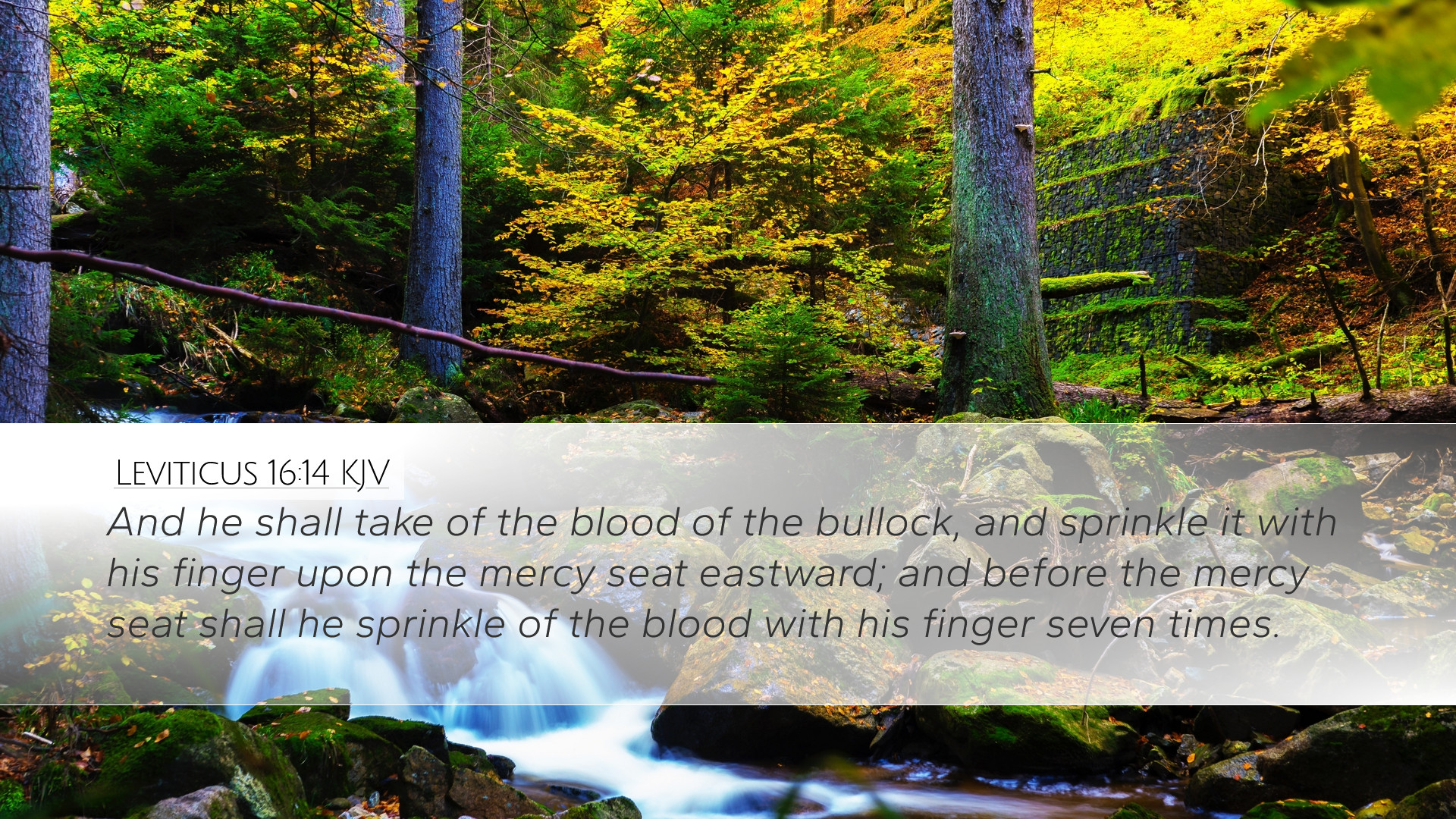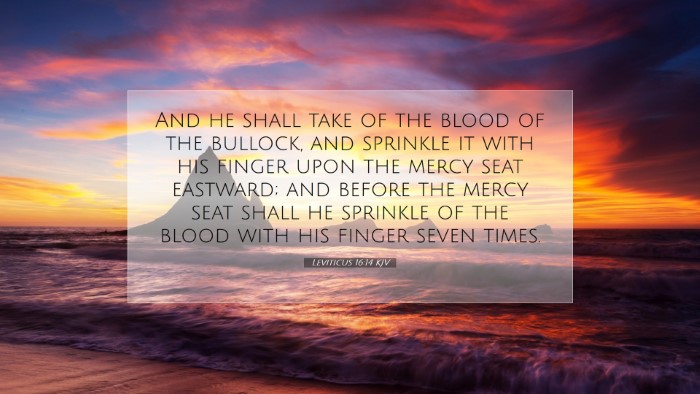Commentary on Leviticus 16:14
Bible Verse: Leviticus 16:14 - "And he shall take of the blood of the bullock, and sprinkle it with his finger upon the mercy seat eastward; and before the mercy seat shall he sprinkle of the blood with his finger seven times."
Introduction
This verse is part of the Day of Atonement (Yom Kippur) ritual, a crucial observance in the Levitical system designed to atone for the sins of the people. The act of sprinkling the blood is laden with theological significance, encompassing themes of sacrifice, purification, and divine grace. This commentary synthesizes insights from prominent public domain commentaries to deepen understanding of this verse, providing reflections pertinent for pastors, students, theologians, and Bible scholars.
Significance of Blood in Atonement
The blood of the bullock is integral to the Day of Atonement ceremonies. According to Matthew Henry, it serves as a critical symbol of atonement, representing life itself, as Leviticus 17:11 teaches that "the life of the flesh is in the blood." The blood signifies the cost of sin and the necessity of sacrifice for restoration and communion with God.
The Nature of Sacrifice
Albert Barnes emphasizes that the sacrificial system was a foreshadowing of the ultimate sacrifice of Christ. The bullock represents Jesus, who would later shed His blood for the sins of humanity. This connection points to the efficacy of Christ’s atonement, linking the Levitical rites to the New Testament revelation of redemption.
Importance of the Mercy Seat
The mercy seat is the lid of the Ark of the Covenant, symbolizing God's presence among His people. Adam Clarke notes that the act of sprinkling blood upon the mercy seat signifies appeasement of God's wrath and the covering of sins. The emphasis on the eastward direction of the sprinkling is also significant, representing both a physical and spiritual orientation toward the presence of God.
The Act of Sprinkling
Sprinkling is a ritual of cleansing and consecration. Matthew Henry highlights that the number seven, used in the sprinkling ("seven times"), denotes perfection and completion. This action illustrates the thoroughness of atonement provided by the sacrificial blood, signifying that all aspects of sin are being covered and dealt with in a complete manner.
The Role of the High Priest
The ritual is carried out by the High Priest, acting as a mediator between God and the people. Both Barnes and Clarke discuss the significance of this mediation, echoing Christ’s role in the New Covenant. Just as the High Priest offers blood for atonement, Christ stands as the great High Priest, having offered His own blood for eternal redemption.
The Holiness of God and Human Sin
The act of carrying out these rituals underscores the holiness of God and the deep seriousness of human sin. The blood is necessary to bridge the gap caused by sin, pointing to the need for continual repentance and a renewed relationship with God. According to Henry, this verse encapsulates the gravity of sin, showing how the shedding of blood is essential for forgiveness.
Application for Today
As modern-day believers reflect upon Leviticus 16:14, they are reminded of the permanence of Christ’s sacrifice. The blood of Jesus provides a once-and-for-all atonement that invites believers into intimate fellowship with God. Here, practical ministry, personal devotion, and theological understanding converge.
Pastoral Reflections
- Emphasize the Gospel: Pastors should preach the message of atonement and the necessity of the blood of Christ, paralleling the Old Testament practices with New Testament truths.
- Encourage Repentance: Regular call for repentance in ministry, reminding congregants that grace comes through recognizing and confessing our sin.
- Highlight God’s Holiness: Teach about the holiness of God and the gravity of sin, linking to the essential need for atonement in Jesus.
Theological Implications
- Covenantal Theology: Understanding the shift from the Old Covenant sacrificial system to the New Covenant established by Christ is essential for deep theological reflection.
- Atonement Theology: Exploring theories of atonement through the lens of Leviticus helps clarify God’s redemptive plan throughout Scripture.
- Sacrificial Paradigm: Reflecting on the nature of sacrifice and its implications for Christian living and discipleship is vital for deeper spiritual formation.
Conclusion
Leviticus 16:14 serves as a reminder of the profound depth of God's love and the lengths to which He went to reconcile humanity to Himself. The sacrificial system, particularly the blood sprinkled on the mercy seat, prefigures the ultimate sacrifice of Christ, fulfilling the requirements of atonement once and for all. Engaging with this verse opens up a wealth of theological and practical implications for believers today, emphasizing the continual relevance of God's Word.


